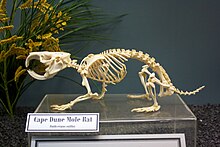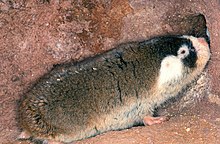Sand diggers
| Sand diggers | ||||||||||||
|---|---|---|---|---|---|---|---|---|---|---|---|---|

Ansells Graumull ( Fukomys anselli ) |
||||||||||||
| Systematics | ||||||||||||
|
||||||||||||
| Scientific name | ||||||||||||
| Bathyergidae | ||||||||||||
| Waterhouse , 1841 |
The sand graves (Bathyergidae) are a family of rodents (Rodentia), where they are classified in the suborder of the porcupine relatives (Hystricomorpha). These are rodents that are mainly adapted to the underground and burrowing way of life.
features

Representatives of the sand graves reach a body length of 8 to 33 centimeters. The jaws and the associated masticatory muscles , which are very strong, are particularly adapted to the underground way of life . The incisors are very long and their roots can reach behind the molars in the jaw ; they are used as digging tools. Body appendages such as the tail and the outer ears are regressed, as are the eyes. All types of sand diggers have short fur.
Way of life
All sand diggers live in self-dug tunnel systems, which they dig with the help of their powerful incisor teeth. They feed vegetarian on underground tubers. Sand diggers can live solitary or in colonies .
distribution
Blesmol now live only in Africa south of the Sahara . The beach graves ( Bathyergus ) and the Cape blessmull ( Georhychus capensis ) as the only representatives of the genus Georhychus are restricted to southern Africa, of the three species the Cape blessmull and the Cape beach grave ( Bathyergus suillus ) only in the Republic of South Africa occur and the Namaqua beach grave ( Bathyergus janetta ) can also be found in the extreme south of Namibia . The gray mull ( Fukomys and Cryptomys ) and the silver-gray earth auger ( Heliophobius argenteocinereus ), on the other hand, are spread over other parts of the region and occur in several countries south of the Sahara.
A fossil species that is assigned to the sand graves comes from Mongolia .
Systematics
|
Phylogenetic system of the sand graves and the naked mole rat
|
The systematic classification of the sand graves in the rodent system is rather controversial due to numerous special formations that have developed mainly due to the burrowing way of life. The relationship to the porcupine relatives is considered certain, but the sister group of the sand diggers is unknown.
According to various molecular biological studies, it is now assumed that the naked mole rat is the most original type of sand burial. The phylogeny of the gray mull is controversial, but on the basis of molecular biological analyzes two clearly separated taxa were identified , whereupon a separation into two genera was proposed and implemented by separating Cryptomys from the new Fukomys genus .

The following taxa belong to the sand graves :
- Gray mull (genus Fukomys Gray , 1864); ten to fourteen species depending on the source
- Cryptomys , only the African gray mullet ( Cryptomys hottentotus ) ( Lesson , 1826)
- Auger (genus Heliophobius Peters , 1846); only the silver-gray earth auger ( Heliophobius argenteocinereus Peters , 1846)
- Beach diggers (genus Bathyergus Illiger , 1811); two types
- Blessmulle (genus Georhychus Illiger , 1811); only the Cape Blessmull ( Georhychus capensis ( Pallas , 1778))
The naked mole rat has long been classified in the family of sand graves (Bathyergidae), with which it still forms a common superfamily today. Due to the genetic distance and the long time separation of the two taxa , however, the species has been assigned to a separate family Heterocephalidae in current works.
supporting documents
- ↑ a b Bruce D. Patterson: Heterocephalidae. In: Don E. Wilson, TE Lacher, Jr., Russell A. Mittermeier (editors): Handbook of the Mammals of the World: Lagomorphs and Rodents 1. (HMW, Volume 6), Lynx Edicions, Barcelona 2016; P. 352 ff. ISBN 978-84-941892-3-4
- ^ A b Colleen M. Ingram, Hynek Burda, Rodney L. Honeycutt: Molecular phylogenetics and taxonomy of the African mole-rats, genus Cryptomys and the new genus Coetomys Gray, 1864. Molecular Phylogenetics and Evolution 31 (3), 2004; Pp. 997-1014. doi : 10.1016 / j.ympev.2003.11.004
- ↑ a b c Dieter Kock, Colleen M. Ingram, Lawrence J. Frabotta, Rodney L. Honeycutt, Hynek Burda: On the nomenclature of Bathyergidae and Fukomys n. Gen. (Mammalia: Rodentia). Zootaxa 1142, 2006; Pp. 51-55.
- ↑ a b R.L. Honeycutt: Family Bathyergidae (African Mole-Rats). In: Don E. Wilson, TE Lacher, Jr., Russell A. Mittermeier (editors): Handbook of the Mammals of the World: Lagomorphs and Rodents 1. (HMW, Volume 6), Lynx Edicions, Barcelona 2016; Pp. 352-370. ISBN 978-84-941892-3-4 .
- ^ Nigel C. Bennett: Genus Cryptomys - Mole-rats In: Jonathan Kingdon, David Happold, Michael Hoffmann, Thomas Butynski, Meredith Happold and Jan Kalina (Eds.): Mammals of Africa Volume III. Rodents, Hares and Rabbits. Bloomsbury, London 2013, pp. 648-649; ISBN 978-1-4081-2253-2 .
- ↑ Bruce D. Patterson, Nathan S. Upham: A newly recognized family from the Horn of Africa, the Heterocephalidae (Rodentia: Ctenohystrica). Zoological Journal of the Linnean Society 172 (4), 2014; Pp. 942-963. DOI: 10.1111 / zoj.12201 .
literature
- RL Honeycutt: Family Bathyergidae (African Mole-Rats). In: Don E. Wilson, TE Lacher, Jr., Russell A. Mittermeier (editors): Handbook of the Mammals of the World: Lagomorphs and Rodents 1. (HMW, Volume 6), Lynx Edicions, Barcelona 2016; Pp. 352-370. ISBN 978-84-941892-3-4 .
- Marc W. Allard, Rodney L. Honeycutt: Nucleotide sequence variation in the mitochondrial 12S rRNA gene and the phylogeny of African mole-rats (Rodentia: Bathyergidae). In: Molecular Biology and Evolution. Vol. 9, No. 1, January 1992, pp. 27-40, ISSN 0737-4038 , PMID 1552839 , oxfordjournals.org .
- AH Walton, MA Nedbal, RL Honeycutt: Evidence from intron 1 of the nuclear transthyretin (Prealbumin) gene for the phylogeny of African mole-rats (Bathyergidae). In: Molecular Phylogenetics and Evolution. Vol. 16, No. 3, September 2000, pp. 467-474, ISSN 1055-7903 , PMID 10991798 , doi: 10.1006 / mpev.2000.0808 .